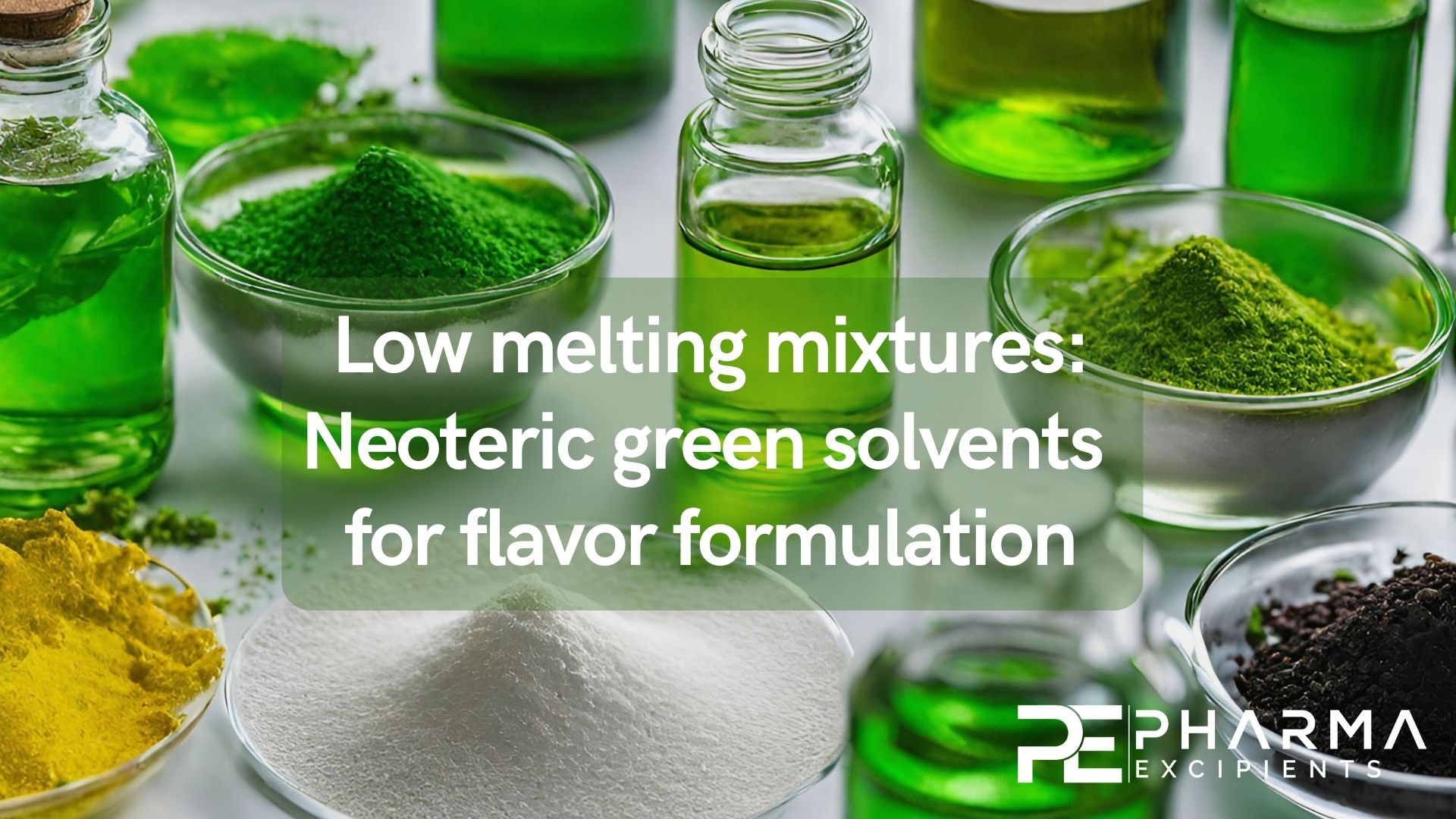Low melting mixtures: Neoteric green solvents for flavor formulation

Abstract
Flavors are considered among the most valuable ingredients in any formula. However, aromatic substances are volatile and can be lost during processing and storage. Thus, it is beneficial to develop strategies for their retention in formulations. The aim of the present study was to evaluate the ability of two low melting mixtures (LMMs) based on food additives, β-cyclodextrin (β-CD) or maltodextrin (MD) and L-lactic acid, and their aqueous solutions, to retain and produce sustained release of flavors. Firstly, β-CD:L-lactic acid and MD:L-lactic acid systems were successfully prepared and characterized. Karl Fischer titration, water activity measurements and 13C NMR showed that these solvents are shelf-stable during long-term storage at room temperature (>5 months). Rheology measurements showed that they were Newtonian fluids. Thermogravimetry (TG) and differential scanning calorimetry (DSC) indicated that they were stable up to 100 °C and that no alteration in their physical properties occurred during several heating/cooling cycles. Their ability to retain and delay the release of two flavors, (-)-limonene and (-)-terpinen-4-ol, was evaluated using static headspace-gas chromatography (SH-GC). The effect of water dilution on their performance was also assessed. The results demonstrated greater efficiency of the supramolecular LMM, β-CD/L-lactic acid, mainly upon rigorous dilution. This was attributed to the ability of β-CD to maintain its encapsulation capacity as confirmed by 2D-DOSY. Additionally, FTIR experiments proved that only physical adsorption takes place. The findings suggest that β-CD:L-lactic acid and MD:L-lactic acid LMMs can be considered for developing easy-to-handle flavor solutions.
Introduction
Flavors are of paramount importance in a wide range of areas. They are essential additives not only in food products but also in pharmaceuticals, perfumes, cosmetics and detergents. The role of flavors in these products goes beyond enhancing organoleptic quality, sensory properties and palatability. They can act as natural preservatives and active agents that are crucial for improving product safety and extending shelf life [1], [2]. However, flavors generally have a low boiling point and limited solubility in water and can be easily lost during product preparation, storage, and use. The chemical structures of flavors are diverse: alcohols, aldehydes, ketones, acids, terpenes, esters and others resulting in different physicochemical properties. It has been suggested that the aromatic characteristics of a product are mainly affected by the type and concentration of the flavor in the food headspace. Therefore, the retention of flavors and the control of their release is a major challenge for the industry. Technologies that aim to improve the performance of flavors are continuing to grow at a steady pace.
Low melting mixtures (LMMs) are neoteric eutectic solvents that fully meet some of the guidelines of the “Twelve Principles of Green Chemistry” (e.g., less hazardous chemical synthesis, atom economy, safer solvents and auxiliaries, use of renewable feedstocks) [3]. They are mixtures simply formed by blending a hydrogen bond acceptor (HBA) with a hydrogen bond donor (HBD). The composition and properties of LMMs can be specifically tuned for a given application by changing the HBA/HBD ratio, exchanging components, or adding a ternary compound such as water. LMMs can be obtained from a wide variety of natural compounds (terpenes, sugars, alcohols, amino acids and organic acids) leading to the formation of safe, sustainable and biodegradable solvents [4]. The use of these green solvents is of great interest to the food industry, since they are considered as an environmentally friendly alternative to conventional organic solvents for solubilization and extraction processes [5], [6]. Indeed, they offer unique advantages due to their high solvent power, low cost and low environmental impact [7], [8]. Several studies have investigated the use of LMMs for the extraction of food contaminants and additives or bioactive compounds including flavors from raw materials, wastes and by-products [6], [7], [9], [10]. However, to the best of our knowledge, no study has dealt with the development of easy-to-handle hydrophilic flavor solutions that can be used during food formulation or added to ready-to-eat products while preventing flavor loss and evaporation.
LMMs with supramolecular properties based on cyclodextrins (CDs) have been recently introduced [11] and reviewed [12], [13]. CDs are biodegradable cyclic oligosaccharides that are naturally obtained by the enzymatic degradation of starch. They are classified as α-, β- and γ-CDs according to the number of glucose units in their composition. (6, 7 and 8 glucose units, respectively) [14]. CDs have a particular three-dimensional structure formed of a hydrophobic cavity and a hydrophilic surface. This allows them to encapsulate compounds in their cavity to form inclusion complexes. In the food industry, CDs are pioneering additives used for many purposes, including solubilization and protection of bioactive valuable compounds such as flavors [15], [16]. Supramolecular LMMs are expected to offer more benefits and improved performance over LMMs that lack supramolecular properties, and generally overcome the barriers associated with burst release of flavors. Recently, a study showed that supramolecular eutectics based on β-CD or its derivatives with lactic acid, provided higher enrichment factors for target organic pollutants than a conventional deep eutectic solvent (Choline Chloride:Urea) [17].
Therefore, the aim of this study was to extend the application of supramolecular LMMs by investigating the ability of formulations consisting of β-CD (GRAS and labeled as E-459, acceptable daily intake: 5 mg/kg body weight per day) and L-lactic acid (GRAS and labeled as E-270) and the conventional LMM composed of maltodextrin (MD) (GRAS and labeled as E-1400) and L-lactic acid (Fig. 1) to act as carriers for flavors. The two LMMs were prepared and characterized (water content %, water activity, rheological properties, FTIR analysis, thermal stability and storage stability). Then, their ability to retain flavors and create controlled release systems was evaluated and compared. The effect of water dilution on these properties was then assessed. (-)-Limonene and (-)-terpinen-4-ol were selected as representative models for hydrocarbons and oxygenated flavors, respectively, due to their structural similarity (Fig. 1). Finally, NMR experiments were performed to demonstrate the inclusion of flavors in the β-CD cavity, thereby confirming the supramolecular identity of the β-CD:L-lactic acid system.
Read more here
Materials
β-CD was provided by Wacker-Chemie (Lyon, France). Maltodextrin (MD) (Glucidex® 12, DP = 9, [18]) was provided by Roquette (Lestrem, France). L-Lactic acid (anhydrous, 98%) was purchased from Fisher Scientific (France). (-)-Limonene (96%) and (-)-terpinen-4-ol (97%) were purchased from Acros Organics group (Germany). All chemicals were used as received.
Miriana Kfoury, François-Xavier Legrand, Steven Ruellan, Sophie Fourmentin, Low melting mixtures: Neoteric green solvents for flavor formulation, Journal of Molecular Liquids, Volume 394, 2024, 123696, ISSN 0167-7322, https://doi.org/10.1016/j.molliq.2023.123696.
Watch our record webinar of “Rational Selection of Cyclodextrins for the Solubilization of Poorly Soluble Oral Drugs” here:


